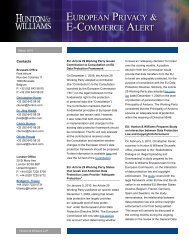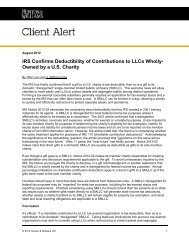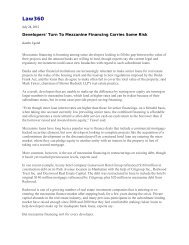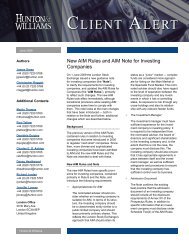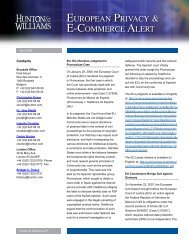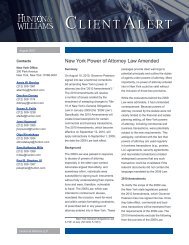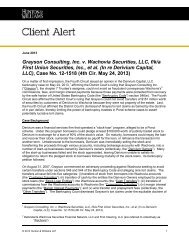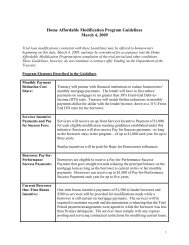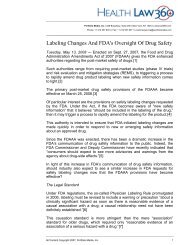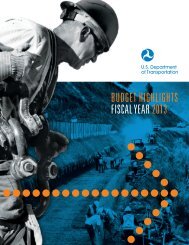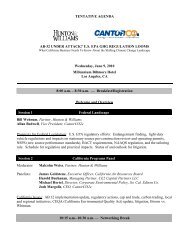Hunton & Williams Renewable Energy Quarterly, September 2009
Hunton & Williams Renewable Energy Quarterly, September 2009
Hunton & Williams Renewable Energy Quarterly, September 2009
You also want an ePaper? Increase the reach of your titles
YUMPU automatically turns print PDFs into web optimized ePapers that Google loves.
<strong>Renewable</strong> <strong>Energy</strong> <strong>Quarterly</strong><br />
concerns iron and steel. For iron and steel products procured<br />
by federal contractors for use as construction material in covered<br />
projects, all manufacturing processes must take place<br />
in the United States (except metallurgical processes related<br />
to refining steel additives).<br />
2. Manufactured Goods<br />
A. FAR Rules<br />
Manufactured goods used as construction materials also<br />
must be produced in the United States. Unfortunately,<br />
the interim rules fail to define precisely what is required<br />
for manufactured construction material to be considered<br />
“produced” or “manufactured” in the United States. The<br />
standard espoused in the interim rules issued by the FAR<br />
Council states that a construction material will be considered<br />
“produced/manufactured” in the United States when<br />
it results from processing into a specific form and shape<br />
or combining of raw material into a property different from<br />
the individual raw materials, and that processing/combining<br />
occurs in the United States. Although this would appear to<br />
be a low standard, it has left many companies in the dark<br />
about whether their U.S. manufacturing activities meet this<br />
amorphous standard. Thus, unlike the criteria for steel in<br />
which all manufacturing processes must take place in the<br />
U.S., for manufactured goods, the use of components or<br />
subcomponents of foreign origin is allowed. Foreign components<br />
— including steel components — can be used to<br />
manufacture a product in the United States. However, the<br />
components have to be incorporated into a further manufactured<br />
or assembled product away from the construction site<br />
(otherwise, they would be considered construction materials<br />
themselves and not components).<br />
B. OMB Interim Guidance<br />
OMB’s definition of “manufactured” differs slightly from the<br />
definition in the FAR. Under OMB’s guidance, a manufactured<br />
good that contains materials from another country must<br />
be “substantially transformed in the United States into a new<br />
and different manufactured good distinct from the materials<br />
from which it was transformed.” The interim guidance<br />
adopts directly the “substantial transformation” test used to<br />
determine a product’s country of origin for trade purposes.<br />
This is a test that the U.S. Customs & Border Protection<br />
(“Customs”) has used for years to determine the country of<br />
origin of an imported product. The problem with this test,<br />
however, is that there are no clear and precise rules.<br />
In response to this lack of clarity, the Environmental<br />
Protection Agency (EPA) has provided some guidance on<br />
what it considers to be a substantial transformation. To help<br />
local utilities determine whether a good has been “substantially<br />
transformed” enough to pass the test, the federal<br />
agency provided a series of questions:<br />
ÆÆ Were all of the components of the manufactured<br />
good manufactured in the U.S., and were all of the<br />
components assembled into the final product in<br />
the U.S.? (If the answer is “yes,” then this is clearly<br />
manufactured in the U.S.)<br />
ÆÆ Was there a change in character or use of the good<br />
or the components in America? (These questions are<br />
asked about the finished good as a whole, not about<br />
each individual component.)<br />
ÆÆ Were the processes performed in the U.S. (including<br />
but not limited to assembly) complex and meaningful?<br />
According to the EPA, an imported component that undergoes<br />
further processing in the United States would not<br />
satisfy the substantial transformation test by “having merely<br />
undergone ‘[a] simple combining or packaging operation.’ ”<br />
Moreover, “assembly operations that are minimal or simple,<br />
as opposed to complex or meaningful, will generally not<br />
result in a substantial transformation.”<br />
Although the EPA has issued guidance on how the substantial<br />
transformation test works, it is uncertain whether<br />
the EPA’s guidance will apply to renewable energy projects,<br />
where most funding comes from Department of <strong>Energy</strong><br />
grants.<br />
3. International Obligations<br />
Pursuant to the ARRA, the Buy American provisions must<br />
be applied in a manner consistent with the WTO Agreement<br />
on Government Procurement (GPA) and U.S. free trade<br />
agreements. Under these agreements, the Buy American<br />
requirement does not apply to iron, steel or manufactured<br />
goods produced in signatory countries and acquired for construction<br />
projects with a value of $7.4 million or more. Thus,<br />
procuring agencies must honor the federal government’s<br />
commitments to treat the foreign iron, steel or manufactured<br />
goods as the equivalent of domestic goods. In determining<br />
whether a product is a product of the GPA or free trade<br />
agreement country, the rules specify that the “substantial<br />
transformation” test is to be used to determine country of origin<br />
when a manufactured good that contains materials from<br />
another country is processed in the GPA or FTA country.<br />
23 <strong>Renewable</strong> <strong>Energy</strong> <strong>Quarterly</strong> www.hunton.com



